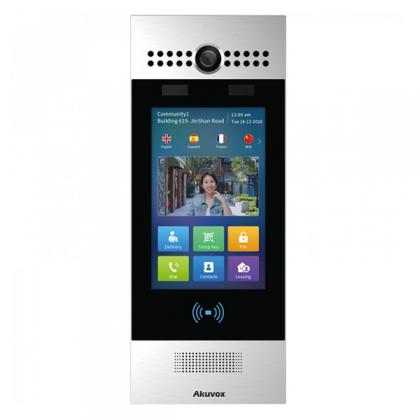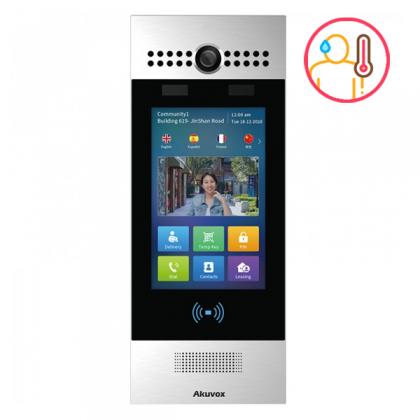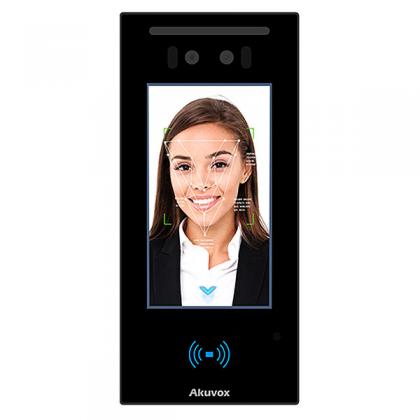What is a door entry system?
Door entry systems are used to regulate access to restricted areas within a businesses or home.
What is a door entry system?
A door entry system - also often referred to as an access control system - is primarily designed to control access to and from a restricted area, building or zone, within residential and commercial environments and particularly multi-tenant / multi-user applications.
There are a wide variety of door entry systems available to choose from; from PIR-triggered automatic doors, to PIN code keypads, contactless proximity readers and biometric door entry using face recognition, fingerprint readers or iris recognition for identity authentication.
A door entry system can be simply an unlocking device, or can serve as a doorbell, resident directory and intercom system - therefore providing total control over who enters a building. They are usually used to allow entry through internal and external doors, but are also frequently applied to unlock and open motorised gates, barriers and car parking entrances.
What types of door entry systems are there?
There are various types of door entry, access and door intercom systems available to choose from, dependent upon the criteria for the system with considerations for type & scale of application, number & demographic of users, required security levels and flexibility of the system, for example.
-
Audio-only Door Entry System
This simple, entry-level type of system relies on verbal verification only. A basic audio door intercom system has a base station (for example, a telephone in an apartment or at an office reception) and a remote/door station located at the required entrance door. When someone presses the ‘doorbell’ button at the door station this then alerts the person at the base station that someone is at the door. The person answers and communicates verbally from the base station with them. The release button is pressed on the base station to unlock the door and allow entry. The benefits of a standalone audio intercom system are they are usually low in cost, there is minimum wiring to the system, they are simple to install and relatively maintenance-free.
One of the key disadvantages of an audio intercom system is the verification method of voice-only is very basic and therefore not secure. It requires a person to be present at the ‘answering’ base at all times and, therefore, is not suitable for 24-hour access applications.
-
Video Door Entry System
A Video Door Entry System is similar to an audio-only system but includes a camera in order for the resident or security officer to provide visual authentication of the visitor’s identity. Like an audio intercom, the video intercom system has a base station or answering device and one or more remote/ door stations. The difference being, however, that the door stations will feature a built-in camera and the answering unit will feature a display screen. The answering unit will usually take the form of either a video phone or an intercom answering panel (a touchscreen device), though increasingly, door intercom systems are allowing for smartphones to be used for face-to-ace video intercom communication and door unlocking.
Pressing the ‘doorbell’ button on the door station activates the unit which then sends an alert to the homeowner or security office, for example, telling them that someone is at the door. The person can then answer from the base station and communicates verbally with the visitor. In a multi-door application, a button is pushed to activate that specific location. An image of the guest can be viewed from the base station. The person who mans the base station can instruct the guest to move closer or farther away from the camera for a clearer picture.
The benefit of a video door entry system is they are usually simple to install – in many cases providing plug-&-play set-up and don’t require high levels of maintenance. A Video Door Entry System also provides a greater level of security than audio-only, of course, with more detailed authentication required.
Video door entry is more expensive than basic audio-only systems, of course. Lighting is also an issue which needs to be considered for video door intercoms as there must be sufficient lighting to accommodate for both day and night time use. This is often considered using low-light cameras and additional built-in infrared cameras. High levels of light must also be considered when locating a video door intercom unit as the changing position of the sun can affect the performance of the device’s camera.
-
Keypad door entry systems
One of the most common door entry systems uses a keypad door station which requires a PIN code to be keyed in manually to gain entry. This type of door entry system can either take the form of the direct door lock or be linked to an electronics access control system which verifies the authentication of the pin code.
Depending upon the technology used, keypad systems may use just one PIN code for everyone, or individual PIN codes allocated to each individual user.The advantage of this system is it is easy to use.
The disadvantage of this system is the safety of the method as passwords/codes can easily be shared.
-
Proximity readers
These are common commercial door entry and access control systems. These systems require the swipe of a key card or fob or increasingly using a smart phone of contactless proximity authentication.
A variety of wireless proximity transmission technologies are available, the most common being RFID, NFC and Bluetooth (BLE). Most keyfobs and keycard systems will use RFID which is available with a choice of frequencies.
Increasingly, NFC and Bluetooth are available as standard in latest generation smart phones and, therefore, provide the ideal contactless proximity method for users, without the need for distribution of specific cards or fobs.
The advantage of this RFID door entry system is that the card or fob can easily be deactivated and replaced if lost or stolen, they are also very affordable. The disadvantage is it is not the safest option down to the fact that the fob or card can be shared with others.
Therefore, smart phone proximity technology provides a more secure and more flexible option.
-
Biometric Door Entry Systems
Biometric authentication provides latest generation door entry and access control systems with the most secure identity authentication using individual’s unique physical attributes such as face recognition, fingerprint or iris scanning to verify a person’s identity to allow entry. Biometric methods are frequently paired with other door entry methods (known as dual authentication) to give the highest levels of access control security.
-
Stand-Alone Wireless Door Entry Systems
The basic stand-alone wireless intercom system is usually used for residential and small commercial applications. The system consists of a wireless base station and a remote/ door station.
Once the doorbell button on the door station is pressed this alerts the person that someone is at the door. The person answers from the base station and can communicate with them verbally.
The advantages of a standalone wireless door entry system is there’s no running wiring, they are simple to install with limited maintenance requirements.
The disadvantage of standalone wireless door entry systems: More expensive than hard-wired units, wireless operating range is sometimes limited to line-of-sight run length. Although communication is wireless (wiring is eliminated between the base and master stations), a wire run from a local power supply may be needed for an electric strike or electrified lock application.
-
Integrated Telephone Door Entry systems
Telephone door entry intercom systems are widely used in a residential environment or in office buildings. The system usually has a master panel at the gate or in the entry. A resident is alerted when someone is at the door/gate when the telephone receiver is used to dial the chosen business /resident or by pressing the doorbell button marked with a name. The residents can then answer from their normal telephone and communicate with the visitor verbally.
The advantages of an integrated telephone door entry system are the systems are available in various sizes to fit different applications. They are mostly plug and play and maintenance free.
The disadvantages, however, are they more expensive than stand-alone systems. Labour is also needed to run power and communication wiring to all component locations. Also, depending on the telephone and cable systems already used, it may require additional interface equipment or technical installation support from a technician which would require additional costs.
Find out more...
Need help with designing your Door Entry System?
CIE is one of the UK's leading distributors of professional door entry, intercom and access control products from leading brands 2N and Akuvox.
Our professional system design team provide a unique system architecture service for installers and integrators to help you deliver the best in door entry and access control technology.
If you would like to discuss your next access control system or would like more information on our full range of security products, please call our team today on T. 0115 9770075 or email us now.
.jpg)













